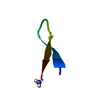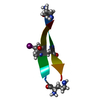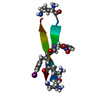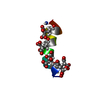[English] 日本語
 Yorodumi
Yorodumi- PDB-1le3: NMR Structure of Tryptophan Zipper 4: A Stable Beta-Hairpin Pepti... -
+ Open data
Open data
- Basic information
Basic information
| Entry | Database: PDB / ID: 1le3 | |||||||||
|---|---|---|---|---|---|---|---|---|---|---|
| Title | NMR Structure of Tryptophan Zipper 4: A Stable Beta-Hairpin Peptide Based on the C-terminal Hairpin of the B1 Domain of Protein G | |||||||||
 Components Components | Tryptophan Zipper 4 | |||||||||
 Keywords Keywords | PROTEIN BINDING / Beta-hairpin / type I beta-turn | |||||||||
| Function / homology |  Function and homology information Function and homology information | |||||||||
| Method | SOLUTION NMR / Hybrid distance geometry, simulated annealing using the program DGII, molecular dynamics using the program AMBER, in conjunction not only with distance, dihedral angle restraints, but also 1H chemical shift-based restraints. | |||||||||
 Authors Authors | Cochran, A.G. / Skelton, N.J. / Starovasnik, M.A. | |||||||||
 Citation Citation |  Journal: Proc.Natl.Acad.Sci.USA / Year: 2001 Journal: Proc.Natl.Acad.Sci.USA / Year: 2001Title: Tryptophan zippers: stable, monomeric beta -hairpins. Authors: Cochran, A.G. / Skelton, N.J. / Starovasnik, M.A. #1:  Journal: To be Published Journal: To be PublishedTitle: Chemical-shift-based methods for structure validation and refinement: Application to tryptophan zipper beta-hairpin peptides Authors: Skelton, N.J. / Cochran, A.G. / Starovasnik, M.A. | |||||||||
| History |
|
- Structure visualization
Structure visualization
| Structure viewer | Molecule:  Molmil Molmil Jmol/JSmol Jmol/JSmol |
|---|
- Downloads & links
Downloads & links
- Download
Download
| PDBx/mmCIF format |  1le3.cif.gz 1le3.cif.gz | 97 KB | Display |  PDBx/mmCIF format PDBx/mmCIF format |
|---|---|---|---|---|
| PDB format |  pdb1le3.ent.gz pdb1le3.ent.gz | 66.8 KB | Display |  PDB format PDB format |
| PDBx/mmJSON format |  1le3.json.gz 1le3.json.gz | Tree view |  PDBx/mmJSON format PDBx/mmJSON format | |
| Others |  Other downloads Other downloads |
-Validation report
| Summary document |  1le3_validation.pdf.gz 1le3_validation.pdf.gz | 331.7 KB | Display |  wwPDB validaton report wwPDB validaton report |
|---|---|---|---|---|
| Full document |  1le3_full_validation.pdf.gz 1le3_full_validation.pdf.gz | 405.9 KB | Display | |
| Data in XML |  1le3_validation.xml.gz 1le3_validation.xml.gz | 6 KB | Display | |
| Data in CIF |  1le3_validation.cif.gz 1le3_validation.cif.gz | 9.9 KB | Display | |
| Arichive directory |  https://data.pdbj.org/pub/pdb/validation_reports/le/1le3 https://data.pdbj.org/pub/pdb/validation_reports/le/1le3 ftp://data.pdbj.org/pub/pdb/validation_reports/le/1le3 ftp://data.pdbj.org/pub/pdb/validation_reports/le/1le3 | HTTPS FTP |
-Related structure data
- Links
Links
- Assembly
Assembly
| Deposited unit | 
| |||||||||
|---|---|---|---|---|---|---|---|---|---|---|
| 1 |
| |||||||||
| NMR ensembles |
|
- Components
Components
| #1: Protein/peptide | Mass: 2012.094 Da / Num. of mol.: 1 / Fragment: C-terminal hairpin of the B1 domain of Protein G / Mutation: Y45W/F52W/V54W / Source method: obtained synthetically Details: This sequence is derived from residues 41-56 of the B1 domain of Protein G with three substitutions from the natural sequence, Y45W/F52W/V54W. The peptide was synthesized chemically. References: UniProt: P06654 |
|---|---|
| Has protein modification | Y |
-Experimental details
-Experiment
| Experiment | Method: SOLUTION NMR | ||||||||||||||||||||||||
|---|---|---|---|---|---|---|---|---|---|---|---|---|---|---|---|---|---|---|---|---|---|---|---|---|---|
| NMR experiment |
| ||||||||||||||||||||||||
| NMR details | Text: The structure of trpzip4 was originally determined using standard 2D homonuclear techniques (Cochran et al., 2001, Proc. Natl. Acad. Sci. USA, 98, 5578-5583). Distance and dihedral angle ...Text: The structure of trpzip4 was originally determined using standard 2D homonuclear techniques (Cochran et al., 2001, Proc. Natl. Acad. Sci. USA, 98, 5578-5583). Distance and dihedral angle restraints were derived from analysis of NOESY, ROESY, DQF-COSY, and COSY-35 data. Chi-1 rotamers and stereospecific assignments for beta-methylene groups were based on combined analysis of 3JHaHb and local ROEs, suggesting that all four Trp residues adopt a chi1 of -60 deg. Quantitative analysis of the 1H chemical shifts, however, revealed that the frequencies of the Hb and He3 resonances of Trp5 and Trp14 were inconsistent with a -60 deg chi1 value, and indicated that the side chains for these tryptophans actually reside primarily in the 180 deg chi1 rotamer (Skelton et al., manuscript in preparation). The current coordinates result from refinement with the Sander module of AMBER (v6.0), and included not only NOE-derived distance restraints and dihedral angle restraints, but also 1H chemical shift-based restraints. Thus, the resulting updated coordinates differ from the previous ones in the side chain orientations of Trp5 and Trp14. However, the rest of the structure is similar with a backbone rmsd between the average coordinates of the two ensembles of 0.72 angstrom(res.43-54). The two strands are highly twisted, as described previously, however there is a slight difference in the relative position of the turn with respect to the strands. The key difference, however, is that each pair of cross-strand tryptophan rings now shows edge-to-face packing against one another. This sort of packing is observed for all tryptophan zipper peptides, regardless of turn type. |
- Sample preparation
Sample preparation
| Details | Contents: 2mM trpzip4 / Solvent system: 92% H2O, 8% D2O, pH 6.0, 0.1mM DSS |
|---|---|
| Sample conditions | Ionic strength: 0 / pH: 6 / Pressure: ambient / Temperature: 288 K |
| Crystal grow | *PLUS Method: other / Details: NMR |
-NMR measurement
| Radiation | Protocol: SINGLE WAVELENGTH / Monochromatic (M) / Laue (L): M | |||||||||||||||
|---|---|---|---|---|---|---|---|---|---|---|---|---|---|---|---|---|
| Radiation wavelength | Relative weight: 1 | |||||||||||||||
| NMR spectrometer |
|
- Processing
Processing
| NMR software |
| ||||||||||||||||||||
|---|---|---|---|---|---|---|---|---|---|---|---|---|---|---|---|---|---|---|---|---|---|
| Refinement | Method: Hybrid distance geometry, simulated annealing using the program DGII, molecular dynamics using the program AMBER, in conjunction not only with distance, dihedral angle restraints, but also 1H ...Method: Hybrid distance geometry, simulated annealing using the program DGII, molecular dynamics using the program AMBER, in conjunction not only with distance, dihedral angle restraints, but also 1H chemical shift-based restraints. Software ordinal: 1 Details: Structures are based on a total of 130 (including 29 intra-residue, 30 sequential, 20 medium-range, and 51 long-range) NOE-derived distance restraints, 22 dihedral angle restraints, and 1H ...Details: Structures are based on a total of 130 (including 29 intra-residue, 30 sequential, 20 medium-range, and 51 long-range) NOE-derived distance restraints, 22 dihedral angle restraints, and 1H chemical shift restraints for 46 carbon-bound 1H resonances; (chemical shift restraints were not imposed for the terminal residues, or for side chains exhibiting evidence of rotational averaging). The ensemble agrees well with the experimental restraints with no distance or dihedral angle violations greater than 0.10 angstrom or 5 deg, respectively, and an average rmsd of only 0.106 ppm between observed and calculated chemical shifts. | ||||||||||||||||||||
| NMR representative | Selection criteria: closest to the average | ||||||||||||||||||||
| NMR ensemble | Conformer selection criteria: structures with the least restraint violations Conformers calculated total number: 64 / Conformers submitted total number: 20 |
 Movie
Movie Controller
Controller












 PDBj
PDBj Amber
Amber